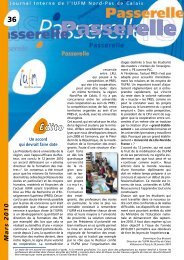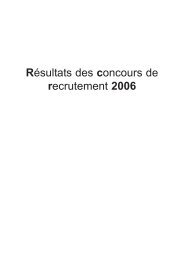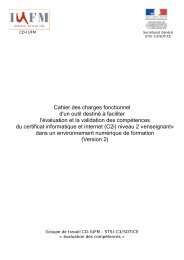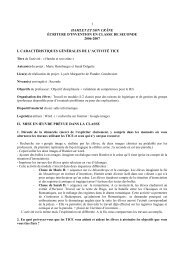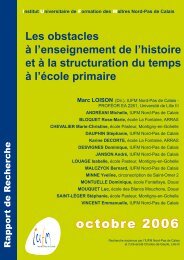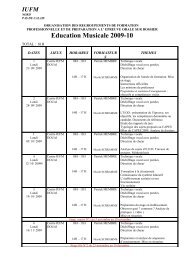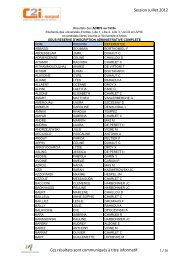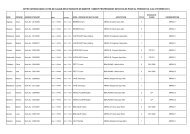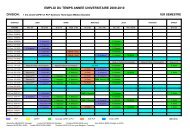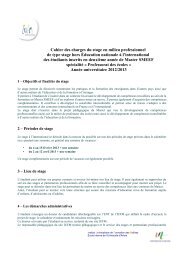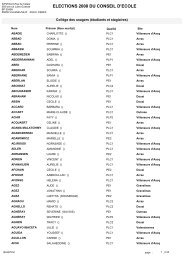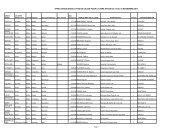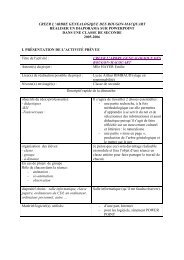You also want an ePaper? Increase the reach of your titles
YUMPU automatically turns print PDFs into web optimized ePapers that Google loves.
2.2.1. Split implicative ways : the examp<strong>le</strong> of different geometric skills.<br />
Studying the graph’s data showing the implicative links between the different items kept<br />
makes it possib<strong>le</strong> to dissociate two implicative ways. One of the networks links the items<br />
which take into account points A, B, C, D to those that determine the diagram’s e<strong>le</strong>ments in<br />
relation to the others and lastly to a central item, the one that shows that the pupil not only<br />
takes into consideration point O but also gives it at <strong>le</strong>ast two different status : for examp<strong>le</strong><br />
from being the centre of the circ<strong>le</strong>, it becomes the lines intersection or the square’s centre.<br />
A second network links items which, on the contrary indicates that the pupils didn’t take<br />
into account the different points (“ONM” and “ABCDNM”) to those that mark the absence of<br />
constraints between the different e<strong>le</strong>ments of the diagram.<br />
The first network gathers writing productions where the diagram’s analysis are rather analysis<br />
in terms of punctual structures with communication of constraints try outs, which have a<br />
weight on the drawing out of the different e<strong>le</strong>ments. The second network gathers texts which<br />
are more like descriptions, in which pupils only need to mention visib<strong>le</strong> lines and sometimes<br />
their respective topological positions (inside, on). The first type output is for us an indication<br />
that the skills to move on to “a construction program task” are met, whereas the second type<br />
output is more the indication of an interpretation of a task in terms of “description of a regular<br />
drawing”. So, S.I.A., by the way of differencing implicative ways allows displaying separate<br />
geometric connected skills.<br />
2.2.2. The networks’ nodes : crucial points.<br />
If the dissociation of implicative nodes in a graph is interesting, the identification of nodes in<br />
the different networks is no <strong>le</strong>ss interesting. What we call nodes here are the items that take<br />
part into several links.<br />
In the first network we notice how important the node is “O appears and goes through a<br />
change of status”. As a matter of fact, pupils can mention the centre of the circ<strong>le</strong> or the<br />
midd<strong>le</strong> of two lines without having to get into a perspective of linking both lines (or even<br />
saying it).<br />
Therefore it is indeed the change of status (in turn centre of the circ<strong>le</strong> and intersection of<br />
lines or centre of the circ<strong>le</strong> and intersection of the diagonals) which makes up the decisive<br />
criterion to fi<strong>le</strong> the pupils production and its grading.<br />
Trusting the reader with this change and finding the discursive ways to do so might be a<br />
crucial stage. It involves indeed to be ab<strong>le</strong> to find the means to bring back, to recall an<br />
e<strong>le</strong>ment already present in the text (therefore a handling or the imp<strong>le</strong>ment of anaphoric<br />
ways), it also implies to be ab<strong>le</strong> to get away from visual evidence of the figure, in short to be<br />
ab<strong>le</strong> to go beyond an immediate visual contact to a written account of an invisib<strong>le</strong> change.<br />
Point O doesn’t move but his function changes.<br />
So S.I.A. allows proving as evident the deciding ro<strong>le</strong> played by some analysis criteria and<br />
their necessary presence in skills evaluation.<br />
<strong>IUFM</strong> Nord-Pas de Calais<br />
113




